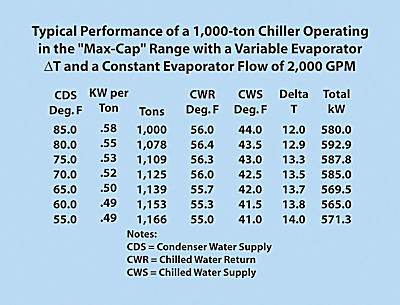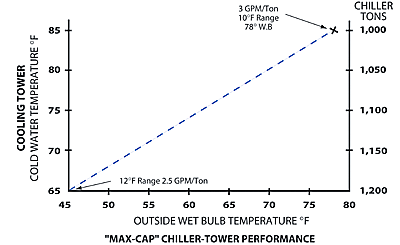
This design wb temperature may occur less than 1% of the year. At all other times, the wb and condenser water temperature will be less and the chiller capacity will be greater than the rated capacity.
Chiller operation in this "greater than normal" range is often referred to as the "max-cap" range and varies greatly with manufacturers and models. The max-cap range may be as little as 100% to 105% of the nominal rating, or as great as 100% to 140% of the nominal rating.
A max-cap range is present on almost every system (new or old) with halocarbon compressors. The kW/ton when operating in the max-cap range is generally less than the kW/ton when the chiller is operating at design conditions, and it is often less than when the chiller is operating at the most efficient part-load condition.
Therefore, all central plant chillers should be configured so that the chiller(s) can utilize the savings that the max-cap range provides. Plants with single chillers that only operate during the day can also benefit. The added max-cap capacity on startup decreases the building cool-down time so that the start-up time can be delayed.
The variable primary system in Figure 1 is an example of how the max-cap range is utilized. The chillers are staged on from a temperature sensor T-1 in the chilled water supply. The differential pressure sensor DP-2, through the VSD, controls the speed of pumps P-1 and P-2. The differential pressure sensor DP-1 is used to control valve V-4 when it is necessary to maintain a minimum flow through the on-line chiller(s) (optional). Valves V1, V2, and V3 are chiller isolation valves that are closed when the chillers are off.
Each chiller has a rated capacity of 1,000 tons at 85 degrees entering condenser water when cooling 2,000 gpm of chilled water from 56 degrees to 44 degrees (2 gpm/ton and 12 degrees delta T). The chilled water gpm/ton and the delta T rarely operate at design conditions in variable primary systems. Either can be more or less than the design quantities. The condenser water from each chiller is cooled by a cooling tower rated at 1,000 tons (15,000 Btu/ton) when cooling 3,000 gpm of condenser water from 95 degrees to 85 degrees (3 gpm/ton and 10 degrees approach).
Figures 2 and 3 chart the performance of a 1,000-ton chiller as the condenser water temperature decreases from 85 degrees to 55 degrees as the outdoor wb temperature decreases.
In a variable primary system, there are an infinite number of operating conditions because of the varying flow and varying delta T. To reduce the scope of this article, the delta T in Figure 2 is shown constant at 12 degrees and the flow is varied. In Figure 3, the flow is constant at 2,000 gpm and the delta T is varied.
In order to use the additional cooling capacity available from the chillers when they are operating in the max-cap range, the chilled water flow and/or the deltaT must increase. When chillers are staged "on" from the chilled water supply temperature T-1 and the load (flow) is increasing, flow through the on-line chillers will increase to use the max-cap capacity as shown in Figure 2.
If the load continues to increase above the setting of T-1, the next off-line chiller will be activated. The load (flow) in Figure 2 is shown increasing from 2,000 gpm to 2,464 gpm to use the additional capacity in the max-cap range. The increase in evaporator pump transport energy (kW) to handle the increase in flow was added to the chiller kW to arrive at the net kW/ton. The net kW/ton for each on-line machine has decreased from 0.58 to 0.48 and the cooling capacity has increased from 1,000 to l,233 tons (23.3%). The kW draw has increased from 580 kW to 598 kW. The 233 tons of max-cap capacity was produced using less than 0.08 kW/ton of additional power.
In order to use more of the max-cap capacity, the delta T in Figure 3 is shown increasing from 12 degrees to 14 degrees. The kW/ton decreases from 0.58 to 0.49, and the total kW decreases from 580 to 571 as the delta T increases from 12 degrees to 14 degrees. The chiller kW load decreased 1.5% and the cooling capacity increased 11.6% from 1,000 to 1,166 tons as the condenser water supply decreased from 85 degrees to 55 degrees.
In this example, the leaving chilled water temperature sensor on each chiller must be set at 41 degrees and the supply chilled water temperature sensor T-1 at 44 degrees. This will permit the chilled water supply temperature to float between these limits, thereby enabling the chiller(s) to operate in the max-cap range.
In real time operation, the delta T and gpm/ton will both continually vary in a properly designed and controlled variable primary system. Since both are varying when operating in the max-cap range, the actual kW/ton may be less than shown in either Figure 2 or 3.
Figure 4 is a graph of the chiller maximum capacity and cooling tower cold water temperature vs. the outdoor wb temperature. The dashed line is the max-cap cooling capacity of a 1,000-ton chiller as the outdoor wb temperature varies from 78 degrees to 45 degrees and the condenser water entering the condenser varies from 85 degrees to 65 degrees.
For example, when the outdoor wb is 65 degrees, the chiller maximum capacity is 1,080 tons. When the outdoor wet temperature is 55 degrees, the chiller maximum capacity is 1,140 tons. When the condenser water temperature is 65 degrees this tower/chiller combination is producing its maximum capacity of 1,200 tons at 2.5 gpm/ton. Any further decrease in condenser water temperature may not increase the cooling capacity because of the load limiting characteristics of the chiller.

Summary
For the past thirty years the generic design for central chilled water plants has been "primary/secondary" (and "tertiary" when outlying buildings are included). As a result, there are thousands of these systems all over the world. This is unfortunate, since these systems are not capable of operating over the entire max-cap range because the chillers are customarily staged from flow.Fortunately, the cost to retrofit a primary/secondary system to one that can operate in the max-cap range and utilize the savings is very inexpensive. The retrofit has always resulted in a drastic reduction in cooling costs 1, 2. All it takes is the installation of a check valve in the bypass line and a revision to the chiller control program.
Past ASHRAE president Jim Wolf noted in a presentation on climate change that an increase in chiller efficiency of 15% would reduce power plant emissions by:
- Nearly 17 billion pounds of CO2;
- Over 14,000 pounds of SO2; and
- Over 59,500 pounds of NOx.
Or the equivalent of:
- Removing 2 million cars from the road.
- Planting nearly 500 million trees each year.
These benefits would almost double if all existing and all new chilled water plants were primary only, where the payback for the primary/secondary to primary-only retrofit is measured in weeks or months and energy savings of 15% to 25% are the norm. The retrofit cost is a fraction of the cost required to improve the chiller efficiency 15%.
Operation in the max-cap range may be an alternative to a waterside economizer system since the chillers can operate in this range whenever the outdoor wb is below design. The added capital expense of the waterside economizer installation may prove more expensive than operating the chillers in the low kW/ton max-cap range. Generally, the operation of the waterside economizer system is limited to the short periods when the outdoor wb is below 45 degrees.
Note: It may be necessary for the design engineer to consult with the chiller manufacturer to verify the max-cap range of the new or existing chiller under consideration.
A major chiller manufacturer provided the performance data for the charts in Figures 2 and 3. Data from other manufacturers may be different. A major cooling tower manufacturer provided the data for the graph in Figure 4. Graphs for controlling condenser water systems at other than design outdoor wbs and other cooling tower operating conditions, should be available from all tower manufacturers. ES
EDITOR'S NOTE: Some images associated with this article did not transfer to the Internet. To view the images, please refer to the print version of ES.
Headquartered in Memphis, Kele is a premiere supplier of interface devices for the HVAC and building automation industry with a focus on flourishing in the area of personal customer service. The cornerstone of its effort is to establish lifelong customers who think of Kele first and foremost when seeking application and supply solutions.
